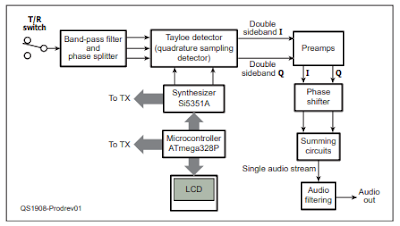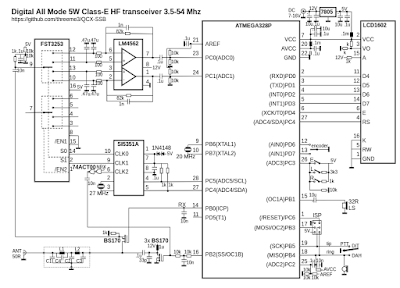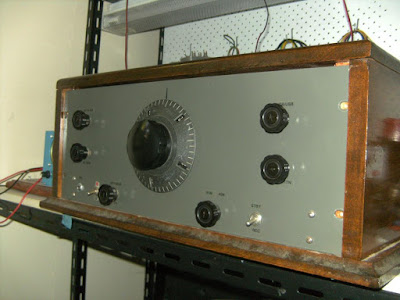Podcasting since 2005! Listen to Latest SolderSmoke
Monday, August 30, 2021
Adding Automatic Gain Control to the Termination Insensitive Amplifier
Sunday, June 6, 2021
VK3HN on Scratch Building (Video)
Lots of wisdom and good info in Paul Taylor's presentation.
Paul's comment on the impact of abundant LiPo power in the field -- we no longer have to scrimp and optimize power consumption -- was very interesting.
And thanks for the nice mentions of the SolderSmoke podcast.
Thanks Paul!
Saturday, May 22, 2021
VK3HN's Homebrew 30 Meter SST QRP Transceiver
Tuesday, May 18, 2021
HRDX Interviews Paul Taylor VK3HN
Wednesday, March 31, 2021
Mending vs. Ending -- The Fight Against Planned Obsolescence
We don't get a lot of mail from Darwin, Australia, so the message coming in from Phil VK8MC immediately got our attention. When I looked into the details I realized that it was very SolderSmoke-relevant. The Guardian article that Phil cited even mentions hobbyists tinkering with electronic devices in their sheds (that would be us!). Phil points to the connection between our repair efforts and the struggle to save the planet: "It's not just a hobby, it's an ethical position which contributes to the well being of the planet. A higher calling indeed!"
Here is the article Phil pointed us to:
The poster above (which hangs above my workbench) is from https://www.ifixit.com/Manifesto.
Sunday, March 28, 2021
"The Dish" Turns 60
Monday, March 15, 2021
Aladdin's Lamp == The Vacuum Tube (aka The Thermatron) (Video)
Sunday, December 20, 2020
The Parkes Radio Telescope Picks Up a Possible "Wow" Signal from Proxima Centauri (maybe)
An article about SETI and our favorite dish. From Scientific American:
Thursday, November 26, 2020
VK3YE's Super Simple Phasing Receiver
Sunday, November 22, 2020
The Wizard of Horseshoe Bend: VK2FC's Wonderful Projects
http://www.vk2fc.com/progressive_receiver.php
Glen's site has many other projects. Check them out:
http://www.vk2fc.com/index.php
And here he is, the Wizard of Horseshoe Bend:
Saturday, November 14, 2020
The Dish -- Virtual Tour -- New Indigenous Name
Friday, November 13, 2020
How Does My Singly Balanced, Two-Diode, Single Transformer Product Detector Really Work?
As young James Clerk Maxwell used to say, "What's the go of it?" and "What's the particular go of it?"
I studied this circuit carefully when I was using it as a balanced modulator in my DSB rigs. I wrote up my conclusions in my book "SolderSmoke -- Global Adventures in Wireless Electronics."
BALANCED MODULATOR CONFIGURATION:
When I was using it as a balanced modulator, I had the RF "carrier" signal going into L1. This RF signal was 7 dbm, enough to switch the diodes on at voltage peaks. With the "center tap" of L2/L3 grounded for RF, this meant that when the "top" of L2 is negative, the "bottom" of L3 is positive. In this situation BOTH D1 and D2 will turn on and conduct.
When the top of L2 is positive, the bottom of L3 is negative and neither of the diodes is on. Neither conducts.
So we have the RF signal turning the diodes on and off at the frequency of the RF signal.
Audio from the microphone and mic amplifier is sent into the center tap connecting L2 and L3. The level of this audio is kept low, below the point where is could turn on the diodes. The center tap IS grounded for RF by the .1uF capacitor, but it is NOT grounded for AF. That is key to understanding this circuit.
In essence by turning the two diodes on and off at the rate of the RF signal, the audio signal is facing severe non-linearity through the diodes. We could say it is alternately being multiplied by 1 and 0. This non-linearity is what is required for mixing. We therefor get sum and difference products: Sidebands. At this point, Double Sideband.
The way the transformer is set up means the RF carrier signal is balanced out: Even when the two diodes conduct, the top of R1 and the bottom of R2 are of equal and opposite polarity, so there is no carrier signal at the junction of R1 and R2 (they are actually a 100 ohm variable resistor that can be adjusted to make SURE they balance out). So the carrier is suppressed and all that remains are the sidebands: Suppressed Carrier Double Sideband.
PRODUCT DETECTOR CONFIGURATION:
What happens when we use this circuit as a product detector in a receiver? Let's assume we are working with a 455 kc IF. If you run a 454 kc 7 dbm BFO signal into L1, it will turn the diodes on and off as described above. But you will NOT be able to put the 455 kc IF signal into the center tap of L2/L3 -- that center tap is GROUNDED for 455 kc. So you will have to run your IF signal into the resistors, and take the audio output from the center tap of L2/L3. This works. I tried it in my HA-600A. But there is a problem: Envelope detection.
In this arrangement, we are balancing out NOT the 455 kc IF signal, but instead we are balancing out the BFO. We don't really NEED to balance out the BFO -- it can easily be knocked down in the audio amplifiers, and IT is not responsible for the problematic envelope detection. We DO need to balance out the IF signal, because if that gets through we can get simultaneous "envelope detection" and product detection. And believe me, that does not sound good.
So I tried putting the IF signal into L1, and the BFO signal into the resistors (as shown above). I took the audio from the junction of L2/L3. This seemed work better, with envelope detection greatly reduced.
BUT WHAT'S THE GO OF IT?
But how is this circuit mixing in this configuration? The strong BFO signal is still controlling the diodes, BUT, with the BFO signal coming in through the resistors, when the top of R1 is positive the bottom of R2 is ALSO positive. In this situation D1 will conduct but D2 will not. The IF signal is facing a big non-linearity. This will result in sum and difference frequencies. The difference frequency will be audio. But with D1 and D2 turning on and off in a very different way than we saw in the balanced modulator, how does the mixing happen?
I think the answer comes from the summer 1999 issue of SPRAT, the amazing journal of the G-QRP club. Leon Williams, VK2DOB wrote an article entitled "CMOS Mixer Experiments."
Here is Leon's 74HC4066 circuit:
I think those two gates (3,4,5 and 1,2, 13) are the functional equivalent equivalent of the two diodes in our product detector. In Leon's scheme the VFO is supplying signals of opposite polarity. Ours is providing only one signal, but the fact that the diodes are reversed means that they act just like the gates in Leon's circuit. The transformer is almost identical to the one we use in the product detector.
Let's look at the output from Leon's circuit:
Monday, October 26, 2020
VK3YE: Solving the Direct Conversion RX -- Double Sideband TX Incompatibility Problem
Saturday, August 1, 2020
SolderSmoke Podcast #224: Mars. Spurs. Bikes. SDR. NanoVNA. Antuino. MAILBAG
Monday, July 27, 2020
Paul Taylor's Quarantine "Summit Prowler 7" and some Radio Archaeology
Paul Taylor VK3HN has really outdone himself in this video (above) and blog post. He describes coming across a somewhat mysterious homebrew SSB exciter with some cryptic markings on it. Paul eventually figures them out. We still don't know who the builder VK3WAC was -- can anyone find him in their logbooks?
As Paul goes through the description of the transceiver he built around the mystery exciter, he mentions a number of hombew heroes including Farhan VU2ESE, Peter DK7IH, Eamon EI9GQ (I have to get his book!), and Don W6JL. Also, our beloved SSDRA book plays a prominent role in the story.
Paul's video is really beautiful -- at one point the camera pans the landscape and we see kangaroos in the field. It is also refreshing -- as we suffer in the heat of the northern hemisphere summer -- to see Paul and his friends out on the summits in their winter coats and hats.
It looks to me as if Paul built this rig during the current emergency, so I will list it as a Quarantine rig. Every dark cloud has a silver lining, and Paul's rig has added a bit of silver to the dark COVID cloud. Thanks Paul.
https://vk3hn.wordpress.com/2020/07/26/something-old-something-new-a-four-band-5w-50w-ssb-cw-transceiver-summit-prowler-7/
Sunday, July 5, 2020
The Ceramic Spurs (not a rock group)
| +/-6kc filter upper left, 455B wide filter to the lover right. |
| Q-31 with can for first IF amps and filters open |
Sunday, May 31, 2020
QCX SSB -- But How Much QCX Remains?
Hack-A-Day carried a very nice video describing recent efforts to turn Hans Summers' amazing QCX CW monoband transceiver into a multi-mode, multi-mode (including SSB) rig (see above). This is project will greatly interest QCX and SDR fans.
But I wondered how much of the old QCX is still there after the modification. Not much, it turns out.
Here is the bloc diagram of the QCX. It is essentially a phasing rig, using the same principles as my venerable HT-37 transmitter and my version of KK7B's R2 receiver:
Friday, May 22, 2020
I,Q, and HRO: VK2BLQ's Phasing Receiver with an HRO Dial
Monday, May 18, 2020
Homebrew Az-El Satellite Antennas from the Philippines and Australia
https://nightskyinfocus.com/2020/05/18/diy-satellite-tracker/
DU1AU is way ahead of where I was when I was working with Low Earth Orbit satellites. I just aimed the antenna about 45 degrees up from the horizon, and spun it around with a TV rotator with me --not the computer -- as the controllers of the rotator. In essence I did the AZ manually and completely ignored the EL. This design moves the antenna in Azimuth and Elevation, and has the computer control the movements via an Arduino. FB.
DU1AU points to the work of VK3FOWL and VK3YSP. Their site has very detailed info on how to build several versions of this kind of Az-El rotator:
https://www.sarcnet.org/rotator-mk1.html
This Az-El project represents a great opportunity to move beyond hand-held satellite antennas, and beyond my Az-only manual approach. It also give us a way to bring some real homebrewing into a part of ham radio that has come to be dominated by commercial equipment. There are some Arduinos and some lines of code, some motors and some metal work. Great stuff!
Tuesday, March 31, 2020
Quarantine Rig: VK3YE Resurrects an Old BITX Project
I think we should start calling these "Quarantine Rigs." Many of us are pulling off the shelves rigs that we started a while back but then put aside. Now, with the pandemic, we have the time (and the need!) to work on them.
I like Peter's BITX receiver video, especially the part in the beginning where he wipes the grime and oxidation off the long-neglected copper-clad board.
Follow Peter's lead: Pull those old projects off the shelf. Get them going. Now is the time. SITS! Melt solder and flatten the curve.
Thanks Peter.

































